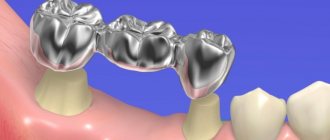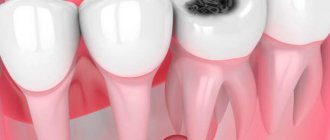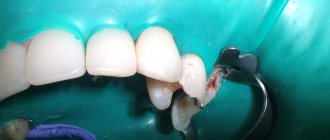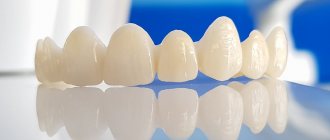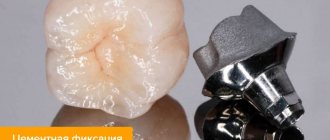The absence of one or more teeth causes discomfort to a person. Chewing may be painful, and if the problem is severe, some foods may need to be completely eliminated from the diet because they are difficult or impossible to chew. This phenomenon suggests the development of diseases of the gastrointestinal tract and other systems. Don't forget about the aesthetic side. The absence of teeth, especially in the front, contributes to the appearance of complexes. A person becomes ashamed of himself, stops smiling, and sometimes even limits his circle of communication with people. In modern dentistry, various prosthetic methods are used, so restoring the dentition does not pose a serious problem.
One of the methods of smile reconstruction is the installation of removable plate dentures.
What are plate prostheses?
Plate dentures, as the name suggests, are plates of different sizes. They act as the basis of the structure, its base. Fastenings and artificial teeth are mounted to them. Previously, such dentures were made exclusively from hard materials, but today dental technicians have a wider choice. This allows you to select products individually for patients, based on their needs and financial capabilities. But here it should be remembered that not only the comfort of wearing a prosthesis, but also its durability depends on the material.
Indications for removable prosthetics
Removable dentures are installed in the following situations:
- the absence of several teeth in the dentition and the impossibility of fixed prosthetics;
- patient's refusal of fixed dentures;
- complete loss of teeth - adentia;
- loss of a large number of teeth (direct dentures);
- loss of 1 tooth (cosmetic prosthesis);
- for infectious-inflammatory and degenerative-dystrophic diseases of periodontal tissue (periodontitis or periodontal disease);
- severe general diseases that are contraindications for fixed dentures;
- individual intolerance to metal structures.
Removable dentures are an ideal option if you have lost several side teeth in a row on both sides, or if you have lost central teeth while keeping side teeth. This type of denture is very good for edentulous patients if the patient refuses an implant.
List of contraindications
Restrictions on the installation of removable laminar dentures are divided into absolute and relative. In the first case, the product cannot be used due to the impossibility of changing the general somatic condition of the patient. This is observed when:
- schizophrenia;
- epilepsy;
- dental pathologies that cannot be treated;
- individual intolerance to the prosthetic material.
In the group of relative contraindications to wearing a removable structure:
- bite pathologies;
- tuberculosis;
- actinomycosis;
- periodontal diseases;
- infections, acute inflammatory processes;
- rehabilitation after stroke/heart attack;
- exacerbation of a chronic disease.
In the latter cases, the design can be worn only after recovery or the disease has entered the remission stage.
Design features of removable laminar dentures
A plate prosthesis restores the patient's teeth if they have been lost. The product completely covers the sky. This has a negative impact on habit, pronunciation and taste. However, in cases of complete edentia and the impossibility of restoring the full functionality of the dentition using other methods or designs, such an orthopedic device is the best option for restoring the patient’s chewing ability.
Today, patients can install a new generation design with a thin molded base.
A removable denture with partial absence of teeth is considered a non-physiological product, that is, the loads resulting from the act of chewing are transmitted to the oral mucosa, and through it to the alveolar part, jaw bone, and palate.
The installation of such an orthopedic product is justified if you have healthy teeth. A partial denture with a plate is smaller in size than a full denture, which has a positive effect on the fit and the patient's continued quality of life.
On a note! Any plate orthopedic device consists of a frame and a base of artificial teeth. Some types are integrated with clamps.
Advantages and disadvantages of removable prosthetics
Despite the advantages of modern fixed dentures, removable dentures have their own advantages:
- relatively low price;
- ease of manufacture and operation of the orthopedist;
- the ability to choose a material that is suitable for price and quality;
- the ability to restore any dental defect;
- lightness of the prosthesis, the ability to choose the desired shade of material;
- It is not necessary to prepare healthy teeth for prosthetics;
- the possibility of repairing a damaged model in a dental laboratory;
- ease of care.
Mobile dentures solve the problem of restoring the aesthetic and chewing function of teeth in case of their loss and the impossibility of establishing a fixed model, and therefore improve a person’s quality of life.
Despite the simplicity and convenience of installing removable dentures, these designs have more disadvantages than advantages:
- the inability to create a uniform load on the tissues of the upper jaw, which gradually leads to their atrophy (decrease in volume) and the need to change the model (limited time);
- insufficiently reliable fixation in the oral cavity, which often creates problems with chewing and unclear speech;
- difficult process of getting used to wearing; some sensitive people cannot get used to a foreign object in the oral cavity due to soft tissue injury;
- It is impossible to perform prosthetics immediately after tooth extraction, as in the case of one-stage implantation.
Removable dentures should be installed only when there are no other prosthetic options, since there are contraindications for installing bridges or prosthetics on implants.
When are removable dentures of the described type fixed?
A partially removable plate product can help a patient out for a short period when the product is being prepared for permanent wear. Other indications for wearing prostheses include:
- absence of chewing teeth in the presence of supporting teeth;
- the presence of restrictions on the installation of implants;
- allergy to materials used in the manufacture of permanent structures.
The same type of prosthetics is offered if the patient is unable to pay for fixed products.
“Both sides of the coin” of a partial denture
| Advantages of a plate prosthesis | Disadvantages of a prosthesis on plates |
| — uniform distribution of load during chewing - ease of care - short production period - relatively low cost — possibility of installation without the need for preparation - no age restrictions for wearing | - fragility of the material - the prosthesis cannot be subjected to aggressive chewing load – short service life – 5 years — difficulties in the process of getting used to the products (feeling of a foreign body in the mouth, rubbing of the gums) - manifestation of diction disorders during the period of addiction; — the possibility of bone tissue atrophy (not relevant when installing prostheses on implants) — the occurrence of a “greenhouse effect” (temperature difference under the prosthesis and outside it) - can lead to the appearance of bad breath |
Alternative to removable dentures
According to statistics, only about 40% of patients know that removable dentures do not stop the process of jaw bone atrophy. Moreover, more than half would refuse the installation of removable structures in favor of a dental implant if they initially knew about this consequence.
Therefore, it is worth remembering that the long-term absence of teeth leaves its mark on the condition of the bone tissue: in 90% of cases, bone atrophy occurs, caused by a long-term absence of chewing load. This means that with complete edentia there are limitations in the choice of implantation method: the classical approach is difficult due to the need to increase bone volume. Therefore, the choice falls on one-stage implantation methods, which can be performed without bone grafting, as well as with the installation of a prosthesis on the 3rd day.
- All-on-4 technology
A total of 4 dental implants are used for this protocol. But the method has some limitations: its use is justified only with a slight decrease in the volume of the jaw bone, since in a limited space four supports may not be enough to support the entire prosthesis. The method belongs to the group of one-stage implantation protocols, so the prosthesis is installed in a maximum of 3 days.
- All-on-6 technology
This protocol uses 6 implants. Due to the increase in the number of supports (compared to the prosthetic method on 4 implants), the prosthesis is held more securely, which allows the use of this protocol due to a moderate reduction in the volume of the jaw bone. Fixed dentures are also manufactured within 3 days.
- Basal implantation – BASAL COMPLEX
This method allows you to restore lost teeth of the entire row, even in the presence of acute bone atrophy. To do this, install from 8 to 12 dental implants of a special design - they are fixed in deep areas of the bone tissue, more durable and sterile. The prosthesis is installed immediately (usually on the 3rd day), which allows for further stabilization of the implants.
Types of removable laminar dentures
Fully removable plate prosthesis
Used in cases of complete absence of teeth. This is a plastic base with teeth. The plastic bed is made according to individual casts and is made as similar as possible to the gum.
On the upper jaw, the bed is attached with suction cups to the palate, and below - to the alveolar process. As a rule, fixation in the upper jaw is more reliable than in the lower jaw due to the larger contact area.
Partially removable laminar denture
It is used in the absence of several teeth and in the presence of terminal defects. They are a plastic bed with teeth, which is attached to the stumps of the teeth using clamps (hooks) or attachments (locks).
Ease of use depends on the quality of the plastic. The softer the base, the more comfortable it is. In the production of temporary removable dentures, nylon is often used - the most flexible and soft material.
Depending on the material there are:
Acrylic plate dentures
The most common type of removable plate denture is the acrylic plastic denture. This method of prosthetics has existed for a long time, it is very well developed. Its advantage is that it is an affordable type and at a fairly low price you get normal quality. Disadvantage: metal hooks are used for fastening, which are visible when talking. Many patients do not like the presence of such a cosmetic defect, which indicates that a person has a prosthesis. These dentures are suitable for recent tooth extractions. This is due to the fact that when a large number of teeth are removed and a denture is installed, the gum structure becomes very low after some time. When chewing, discomfort occurs, and the denture does not hold well. And since a prosthesis made of acrylic is much cheaper than other materials, it is not a shame to remake it in such a situation compared to an expensive analogue.
Acry Free
Quite a modern material for plate dentures. Acry Free is used for allergic reactions to acrylic. Has greater flexibility and elasticity. Because of this, a full or partial removable plate denture may be slightly thinner. There are no hooks. Fixation occurs due to the overlap of the edges of the teeth, as they blend in with the color of the gums and are invisible. Another advantage is lightness.
How are structures made?
An orthopedist and a dental technician take part in the process of creating removable plate products.
At the first stage, when the need for dental restoration is confirmed, the material for the construction is determined. Then follows the traditional algorithm of actions:
- the orthopedist takes impressions of the patient’s jaw using silicone or alginant impression materials;
- the impression is transferred to the laboratory for casting the required model (the impression is filled with liquid plaster);
- a laboratory employee soaks the plaster model with cold water and makes a wax base, to which the occlusal ridges are subsequently fixed;
- the orthopedic doctor conducts clinical experiments, makes certain marks on the occlusal roller;
- in the laboratory, the characteristics of the bite on the casts are adjusted;
- after installing artificial elements on the base, the orthopedist first tries on the product;
- The dental technician eliminates inaccuracies identified after fitting: corrects the shape, dimensional parameters, and thickness of the product;
- the orthopedist places the finished structure on the jaw and, if necessary, corrects it by polishing the system;
- The dentist installs the final version of the prosthesis for the patient.
Typically, the production of a partial removable plate denture takes no more than 3 weeks. The patient adaptation process is lengthy: it can take up to six months. The duration of this period is influenced by the type of fixation of the product and the type of nervous system of the patient.
Manufacturing and installation of a complete plate prosthesis
Each prosthesis, complete with a removable plate, is unique both in its design and shape, since it is created taking into account the individual characteristics of a particular patient. Orthopedic products are manufactured in a dental laboratory and the process itself consists of several stages:
- Analysis of the condition of the oral cavity and selection of the most suitable design. Before making a decision on prosthetics, the dentist examines the oral cavity. In addition, studies are prescribed, including x-rays using modern equipment. Thanks to the examination, the doctor will receive a complete clinical picture and will be able to identify contraindications to certain medications, materials or other types of medical procedures.
- Sanitation and taking impressions. The doctor takes impressions of your teeth using special material. This procedure may involve taking impressions of both jaws, one jaw, or just part of it. The shade of the future system and the color of the artificial crowns are selected. The resulting impressions are sent to a dental laboratory, where a dental technician, using a digital protocol, models the shape of the prosthesis using a wax template - a base and a crown. The latest CAD/CAM technologies are used to create fully removable structures.
- Making plaster models in the laboratory.
- Modeling with wax.
- Manufacturing of a complete plate prosthesis.
- Sanding and polishing the product.
- Application of a prosthesis by the patient and, if necessary, correction. The doctor checks a wax model of the bite block on the patient's teeth. Adjustments are made and the desired height of occlusion is established, that is, as the patient’s bite is checked, at the same time the appropriate height of the crowns is selected. If the fitting was successful, the doctor will send the results to the dental technician. Manufacturing the finished prosthesis in the laboratory takes about 2-3 weeks.
- Installation of the finished product. The dentist installs the prosthesis with a finished plate and repairs it. The method of fixation depends on the type of structure and the condition of the bone tissue. Next, the doctor will clean and polish the crowns. Sometimes entire removable structures are held in place by a suction effect. If there are suction cups, special gels for dentures are used for durable installation, which can be purchased at pharmacies. They are usually used for the lower jaw.
Stages of manufacturing removable dentures
Since removable dental structures are made individually for each patient, before starting work, a thorough examination of his oral cavity is carried out, including x-rays . The goal is to study the condition of the jaw bone tissues, to determine the presence of anomalies and other deviations. Only after receiving a comprehensive clinical picture can you begin to create a prosthesis.
The process consists of two stages - clinical and laboratory. At the first stage, in addition to examining the jaw, the orthodontist conducts an “aesthetic fitting” - he studies the structure of the patient’s face, selects the shade of enamel and the shape of the teeth that is in harmony with his color type. Then, using dental spoons with plaster, he takes impressions from the lower and upper jaws. A working wax model is cast using them. On it, the specialist specifies the size and relative position of the jaws. Next, a wax prosthesis with teeth made of acrylic plastic is made.
Taking impressions of jaws with dental trays
Thanks to three-dimensional modeling, it is possible to form the surface of the prosthesis, coinciding with the general relief of the tissues in the oral cavity. The volume of the structure should be such as to fill the space underneath as much as possible.
The patient tries on the prototype. The doctor evaluates the appearance, degree of fit to the gums, occlusion (the relationship between the upper and lower dentition). If necessary, changes are made to the model. If neither the doctor nor the future owner has any comments, a prosthesis is made from acrylic (or other material).
A correctly executed design fills the entire prosthetic bed, and its surface looks harmonious with the surrounding tissues. If both conditions are met, the denture is securely fixed in place and does not interfere with biting and chewing.
Breakdown and repair of removable dentures
Failure of removable dentures is a common problem. And it’s not always the dental technician’s fault. Clinical conditions in the oral cavity may be such that the material from which the structure is made quickly deteriorates, becomes porous and brittle.
Failure to follow the rules for caring for a prosthesis or careless handling of it also leads to dire consequences. Microcracks appear on artificial teeth, and the prosthesis itself may even break in half.
The third common cause of breakdowns is non-compliance with manufacturing technology and errors made by the dental technician at the 3D modeling stage.
Do not repair dentures yourself
But the good news is that most broken dentures can be repaired. The main thing is not to do this yourself, but to go to a dental clinic.
The durability of the structure is also affected by the selected material. The cheapest dentures are nylon. They are also the lowest quality. This is the only category of removable dental imitation that cannot be repaired. Such structures can only be thrown away after breakdown.
Dentistry on Narodnaya refused to use nylon dentures in their practice as unreliable, impractical and short-lived.
Methods for fixing plate prostheses
- Metal staples (clamps). The devices can be folded or connected. They extend beyond the base of the product and surround the neck part of the support. Due to the ability to damage the protective layer of teeth, today such hooks are used in exceptional cases.
- Tabs. They are a locking device. The first part is inserted into the prosthesis, and the second into the support (tooth, crown). Reliable fixation is ensured by snapping both parts together using a push-button mechanism.
- Metal-free lids. The best innovative fixation option, which eliminates mechanical damage to the enamel.
Installation of the complete apparatus can be done in the following ways:
- Locks and hooks. This technique can be used when there are multiple teeth.
- Suckers. For the upper jaw, they serve as an additional fastening element.
- Pins. Titanium rods, previously embedded in the jawbone, can be used to install not only fixed, but also removable structures.
Repair of plate prosthesis
Constructions of this type are considered quite fragile, especially where a soft supporting part is attached to artificial teeth. Repairing dentures with removable plates is not always possible, and the degree of success depends on the nature of the damage. For minor nicks or broken hooks and attachments, dentures are often repaired with a removable plate, but major failures usually require a complete redesign. The main reasons for rupture of plate dentures usually lie in careless handling (which often leads to the structure falling off) and attempts to bite hard objects (for example, nut shells).
How to care for plate dentures to extend their service life
- do not eat viscous foods that interfere with the adhesion of the prosthesis to the gums;
- It is recommended to clean plastic dentures after every meal. The process should take about three minutes. If this is not possible, it is better to rinse your mouth with water. In addition, the gums and tongue should be clean, where bacteria also accumulate;
- At night, store the prosthesis in a special box with solution;
- It is best to clean your removable dentures after each meal with a brush and toothpaste. The use of dental floss is encouraged.
- After cleaning, the prosthetic structure is placed in a special solution.
If a plastic prosthesis or any other base is left in a glass of water for a long time, the shape and volume of the structure will change and in the future it will simply become unusable.
How to store and care for a prosthesis?
The finished denture must be cleaned with a brush and toothpaste at least twice a day. After each meal, the product should be rinsed with running water. If there is excessive plaque formation, deposits can be removed by leaving the denture in a special solution.
Removable plate orthopedic products should not be combined with food of a hard or viscous consistency. Eating nuts, toffee, or chewing gum may result in the prosthesis breaking or a crack appearing on its surface.
At night, the structure should be placed in a special container. You cannot store the prosthesis in water for a long time. Otherwise, the product will swell and lose functionality.
Attention! The patient must regularly visit the attending physician to prevent deviations from the norm when using the structure. In case of changes in the configuration of the gums, the selection of new products is indicated.
Ignoring medical recommendations and lack of proper care for dentures can lead to the following complications:
- periodontal inflammation – observed in response to the accumulation of pathogens and the development of gingivitis;
- bad breath - can be caused by bacteria or multiple pores that absorb odor;
- erosions and ulcers on the mucous membrane are the result of tissue injury by the prosthesis and infection of the wound.
